Artículo
Impact of introduced herbivores on understory vegetation along a regional moisture gradient in Patagonian beech forests
Fecha de publicación:
04/2016
Editorial:
Elsevier Science
Revista:
Forest Ecology and Management
ISSN:
0378-1127
e-ISSN:
1872-7042
Idioma:
Inglés
Tipo de recurso:
Artículo publicado
Clasificación temática:
Resumen
Introduced ungulates can alter understory structure and composition posing a serious threat to forest biodiversity. Yet how large-herbivore impacts in forested regions vary along major environmental gradients remains little explored. If ungulate effects shift with habitat conditions, then management could be tailored to protect most vulnerable forests. We tested the hypothesis that the extent of livestock impact on understory vegetation increases with habitat moisture across Nothofagus dombeyi forests in Nahuel Huapi National Park, NW Patagonia, Argentina. Understory composition and species diversity were compared for paired sites (N = 5), which were historically used by cattle or remained free of livestock for more than 50 yr, and were located along a regional precipitation gradient (1500-2800 mm/yr). Long-term cattle presence reduced the cover of sub-canopy trees, shrubs and bamboo by 57-83%, and increased the relative cover of ground-layer herbs, regardless of habitat moisture. Livestock effects on species composition increased towards the wettest forests, which contained more species exclusive to either browsed or unbrowsed sites. Livestock presence increased species richness (α diversity) and within-site heterogeneity (β diversity) in some locations, but mostly reduced species evenness (30%) throughout the moisture gradient. Species turnover at the gradient scale was lower across browsed sites than for livestock-free sites. Our results indicate that the historical presence of domestic cattle induced region-wide changes in understory communities, highlighting the vulnerable nature of the local flora to ungulate disturbance. The greater impact of livestock browsing on the species composition of wetter forests was consistent with the role of plant growth-defence trade-offs along resource gradients. We suggest that the erosion of understory vegetation attributed to domestic herbivores in Patagonian beech forests can be mitigated by adjusting current animal stocks, while moister forests should be given the highest conservation priority.
Palabras clave:
Disturbance
,
Domestic Ungulates
,
Functional Types
,
Herbivory
,
Species Diversity
Archivos asociados
Licencia
Identificadores
Colecciones
Articulos(CCT - PATAGONIA NORTE)
Articulos de CTRO.CIENTIFICO TECNOL.CONICET - PATAGONIA NORTE
Articulos de CTRO.CIENTIFICO TECNOL.CONICET - PATAGONIA NORTE
Articulos(IFEVA)
Articulos de INST.D/INV.FISIOLOGICAS Y ECO.VINCULADAS A L/AGRIC
Articulos de INST.D/INV.FISIOLOGICAS Y ECO.VINCULADAS A L/AGRIC
Articulos(INIBIOMA)
Articulos de INST. DE INVEST.EN BIODIVERSIDAD Y MEDIOAMBIENTE
Articulos de INST. DE INVEST.EN BIODIVERSIDAD Y MEDIOAMBIENTE
Citación
Piazza, María Victoria; Garibaldi, Lucas Alejandro; Kitzberger, Thomas; Chaneton, Enrique Jose; Impact of introduced herbivores on understory vegetation along a regional moisture gradient in Patagonian beech forests; Elsevier Science; Forest Ecology and Management; 366; 4-2016; 11-22
Compartir
Altmétricas




